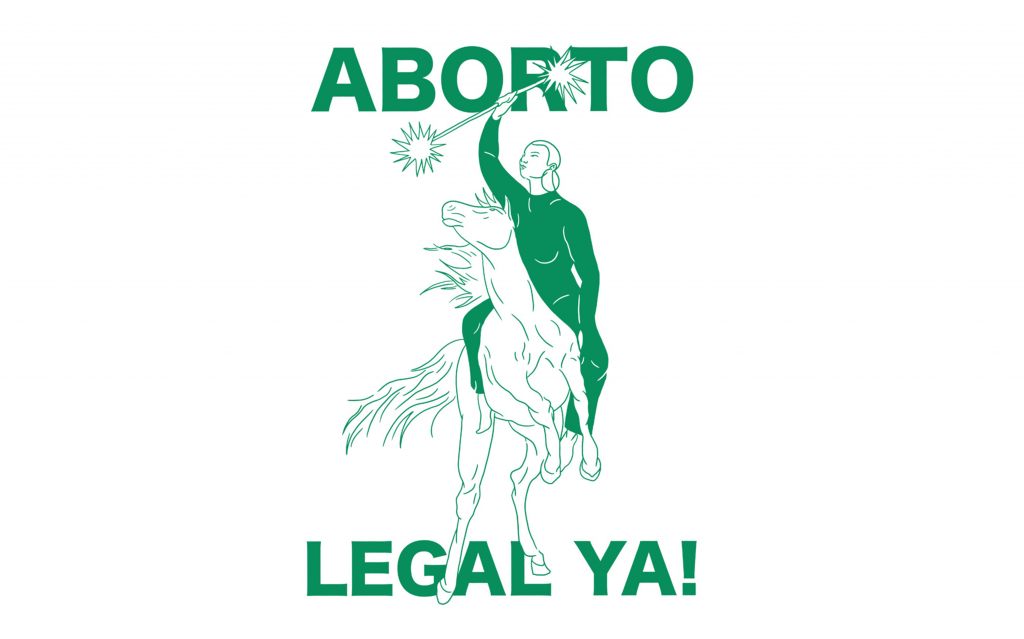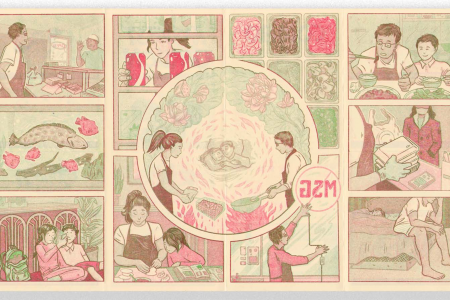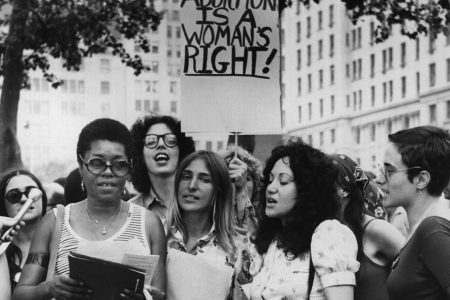
2021 was an extraordinary, schismatic year for abortion politics globally. Some governments lifted long-standing prohibitions against abortion or loosened strict regulations. In the United States, fundamental protections for legal access to abortion are now in peril. Terrorist violence by extremists, a chaotic motif of the 90s abortion wars, has resurged, and people seeking abortions in the US may have to travel hours across state lines to meet with healthcare providers.
In all of this, print materials play a crucial role in connecting people with accurate, up-to-date, and often covert information to ensure their rights are not dependent on where they live or how much money they have. We can look to examples of abortion zines, and the role they play in global abortion activism, to take cues on how to intervene and enable access to safe abortion options now and in the future.
ABORTION ZINES OF THE PAST & PRESENT
Zines often defy singular genres. Today’s abortion zines and even related materials like DIY stickers and cards are packed with a mish-mash of historical, personal, and practical information. The widely distributed Jane: The Legendary Story of the Underground Abortion Service by Judith Arcana, and Free to Choose: A Women’s Guide to Reproductive Freedom by Esther Eberhardt, each detail the history of secret abortion referral networks in Chicago. This network was an organized and defiantly radical solidarity and aid movement that helped hundreds of women before the landmark Roe v. Wade decision in 1973, where the Supreme Court ruled abortion to be federally legal in the US. As Americans contend with new barriers and impending prohibition, these zines are instructive in the use of direct action and mutual aid, while reinforcing the urgency to provide safe abortions regardless of legality.
Complementing these histories are a host of zines featuring personal accounts. These more intimate tracts challenge the reader’s preconceived notions of who has abortions, why they have them, and what the experience is like.
Naturally, first-person accounts fit the zine format well. Anthologies like I’m Not Ready: The Care, Complications, and Contradictions of Experiencing an Abortion demonstrate the vast and complex spectrum of emotions individuals may experience. The zine Thank God For Abortion by artist Viva Ruiz documents the author’s work organizing demonstrations, installations, and performances across the globe with other abortion storytellers and supporters.
Unsurprisingly, the current abortion crisis has also been met by a new wave of self-publishing, this time led by a strain of highly practical, DIY-oriented publications. Their goal is usually to support people in making decisions and accessing the right options. Zines have long been an essential means to share critical health and safety information — for example, at-home abortion medication options, which are far safer and more effective than the self-managed abortion methods of the pre-Roe era. Many are still unaware that abortion medication is available around the world and safe to administer when done correctly. Reproductive Health Access Project publishes zines like Sam’s Medication Abortion to share accurate medical information through the story of personal experience. Moreover, one of the most essential resources in English is the DIY Doula Zine, a comprehensive guide to a safe and comfortable self-managed abortion experience, available to print at DIYDoula.org.


ABORTION ZINES IN THE GLOBAL CONTEXT
In places where abortion is outlawed, the stakes for zine solidarity are immediate and enormous. Help and information must find people wherever they are. That path is inevitably shaped by local political, cultural, and geographical landscapes. Guerrilla print formats such as stickers, flyers, zines, and street art act as signals to abortion-seekers and supporters, directing them towards safe abortion options and solidarity networks. Where street activism emerges, print is usually an important complementary tactic.
Latin America’s legacy of colonization, dictatorships and religious power in government has led to a protracted struggle for abortion activists. In the last decade, activists across Latin America have called for “Aborto Legal Ya” or “Legal Abortion Now,” in English. Green scarves represent their signifying colour. This “Marea Verde,” or “Green Wave” movement, has yielded historic wins like the right to legally abortion Uruguay (2012), the right to legally abort within 14 weeks in Argentina (2020), and the decriminalization of abortion by Mexico’s supreme court won in September of 2021.
These victories were hard-won, the result of decades of effort on multiple fronts: educating the public, advocating for specific policy changes, pressuring the governments through protest and direct action, and all the while continuing to ensure that people seeking abortion found safe options to end their pregnancies. Before the legalization of abortion in Argentina in January 2021, activist press Editorial El Colectivo compiled and distributed an omnibus reproductive health information zine titled Cómo hacerse un aborto con pastillas, or How to Do Your Own Abortion with Pills. This zine was a brave defiance of authorities and became the basis for a website that continues to operates today that shares up to date lists of resources for different countries across the continent. In this way, zines have been at the vanguard of radical knowledge exchange as it has transformed across media and into the digital sphere.
Information and terminology surrounding abortion changes quickly under new legal regimes and across geographies. Editorial El Colectivo’s supplementary website helped improve information accessibility — for example, now videos are available on the site in regional Indigenous languages as well as sign language. These Resources bring local context into a larger solidarity network that spans the hemisphere. In Peru, Hablemos de aborto y misoprostol, in Ecuador, Aborto con medicamento, and Por Nuestras Vidas! in Bolivia all provide information on the local legal context of abortion, information about methods and how to access them safely, and where to go for further reading. Find them at: comohacerseunaborto.com.

“Localized abortion zines in Latin America show us how information compilation can look different based on regions and their unique social, political, and cultural geographies.”
BREAKING THROUGH ONLINE INFORMATION OVERLOAD
For many abortion seekers, internet search engines are the primary gateways to abortion care. But what happens when Google acts as our defacto steward of abortion information and Unsurprisingly, the platform is not quite up to the task, especially since abortion policies specific to countries or states can change rapidly. Despite the common instinct to Google stuff, the search bar simply cannot be trusted to yield accurate, recent, and locally relevant results. Time is of the essence when seeking abortion care and support — following the wrong links might drastically reduce one’s options. That’s why abortion activists consider this persistent “search quality” problem such a big deal. Anti-choice organizations exploit this, using a variety of tactics to deceive and mislead search engine users, such as optimizing the keywords on their own sites to match those of legitimate providers, buying purposefully misleading ads, and opening so-called crisis pregnancy centers (such as fake abortion clinics meant to dissuade clients) that appear on Google maps when users search for a clinic near them. Tactics like Google ad buys are comparatively cheap for anti-choice organizations. Too often, a search for an abortion is an unparseable garbage pile, especially in locales where they are already scarce or taboo.
Google’s very policies not only allow these ad purchases, they might even encourage them. Each ad purchase drives up the price for legitimate providers who might counter them, making Google richer and ultimately pushing accurate information about abortion further down the screen. Certain search terms do trigger a disclaimer that explains which clinics actually provide abortions, but these notes are absent on many related terms.
Try searching for local resources that may help pay for an abortion, for instance, and you are likely to find a number of unmarked links that lead you the wrong way. There is also a lengthy list of countries where Google simply blocks search ads for abortion and contraception entirely, leaving a few hundred million users in the dark. By almost any metric, this is a fundamental breach of search quality. Google just calls it “policy.”
Zines can provide information that can be increasingly vexing to find online in the immediate sense. They also can help teach us a defiant literacy around how to search for what we need. They can model terminology, share histories or tactics, and of course, list the names of organizations committed to the cause. They hold the promise of an alternative system of information, one which reaches across a broad range of organizations, libraries, community spaces, and institutions even beyond reproductive healthcare spheres. When activists and allies can use these channels to effectively reach people and distribute these works, they become a reliable resource base to counteract the corporate search engine paradigm.
CRITICAL INFORMATION IN A POST-ROE REALITY
Most Americans in rural areas and/or states with onerous abortion restriction are already living in the “post-Roe” world we all expect will come out of this Supreme Court. A maze of barriers are stacked against people seeking this kind of care: no appointments for weeks, too expensive, hours away from their home, or all of the above. Roadblocks and restrictions like these are most likely to impact people of colour, poor people, and minors, compounded by states with parental consent laws. With each passing week, the time spent navigating these hurdles leads to delays in procedures, the narrowing of eligibility, and increase in financial and health risks.
These bleak conditions could soon quickly spread and take root. A ruling to overturn the precedent of federally legal abortion established by Roe v. Wade would make abortion instantly illegal in dozens of states, which may very well happen with the Dobbs v. Jackson case. It’s a scary thought.
Consider compiling the above basic information into a simple, easily reproduced zine like the one-sheet, eight-page, snip-and-fold format. Hand them out to those who either may need abortions or want to take action. Keep copies on hand at your workplace, school, or at home. Drop some off at community centres, harm reduction sites, music venues, libraries, or political organizing spaces. Carry them with you to gatherings, shows, protests, and of course, zine fairs!
More into stickers than zines? Visit PlanCPills.org to find printable cards and stickers to help folks find online abortion options. Or make your own stickers directing people to omnibus information websites like ShareSafeAbortion.info or another local abortion resource website of your choosing.
Anti-choice forces in every country are already skilled at using confusion about rulings to proffer misinformation or to make abortion access seem impossible. This fight for access happens on many fronts and information is an enormous one. The legacy of abortion zines shows that each of us, and the institutions and circles of influence we are part of, can be a reservoir of accurate information on where to get an abortion now and as legal contexts change. While these printable materials are temporary, the information they share helps show that our collective right to abortion is not defined by the law nor digital corporate negligence. Together we will protect that right forever.





